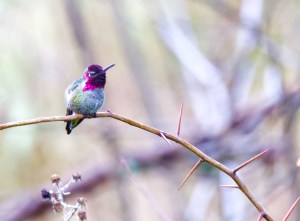Northwest Nature Log Beautiful birds, tangled up in blue
Published 10:27 am Tuesday, July 21, 2015

- Satin bowerbirds like this female are native to eastern Australia.
Over the past few weeks, I’ve been talking about the birds all around us, the charming but mundane geese and starlings. Just for a break, I want to talk about a fascinating family of birds who also are yard birds, but only if you live in Australia or New Guinea. These birds are called bowerbirds, because of the very elaborate “bowers” put together by males of some species of these birds.
Trending
The birds that build bowers are about the size of a crow and their feathers are a deep blue-black. The males sport a bright yellow bill during mating season. These birds live in the wild, but can be found in suburbia as well. It’s common for them to live in the margins of wild areas close to houses. There’s a good reason for this, as you will see.
Males of almost all classes of birds demonstrate some sort of courting behavior: dancing, bowing, certain songs sung only during mating time. But the male bowerbird puts them all to shame.
First, the male searches for and selects just the perfect bunch of dried grasses. He picks them one by one; time is not an issue. Usually these grasses are about eighteen inches long, thin and dried. He carries them in his bill, a few at a time, and sets them on end in two groups to create a sort of covered walkway. Hours are spent rearranging the grasses and perfecting just the right angle. When he is satisfied with his arbor, the real search begins. And this is where the yards of suburbia play an important role. Favorite bits for this bird are things of a cobalt shade of blue. Stones, broken glass, ball point pens, drinking straws. Each item is carefully selected, appropriated, and placed in just the right spot in front of the arbor. This ‘patio’ can extend 1-2 feet in every direction and can be quite beautiful.
Trending
Folks who live near active bowerbirds have learned not to leave small important items outside. Car keys and even paper money have been found in bowers. Blue color isn’t the only defining factor. As much as I love and admire birds, I would have a hard time appreciating a creative bird using my only set of car keys to woo his lady, especially if his bower was well-hidden, as they usually are.
So now, preparations are nearing an end. The arbor leans gracefully, creating a short, covered walkway for the female. The trinkets are arrayed just on the threshold, so that prospective mates will walk through the arbor and then be presented with the shimmering collection of baubles painfully amassed. But it’s not over yet.
Enticing an interested female can be tricky. The male hangs around among his collection, fussily rearranging the pieces. When a mate-seeking female shows up, she will walk slowly through the arbor portion, then look carefully at the treasures arrayed in front. At this point the male begins an elaborate strutting dance which includes feather fluffing, exaggerated steps and best of all, athletic jumps straight up in the air.
Picture a human female, ho-humming, carefully inspecting her fingernails. Behavior doesn’t betray interest.
If the female walks on, you can almost imagine a look of astonished disbelief on the male — that wasn’t enough??
More rearranging follows and more ladies visit the bower. Interested females will visit bowers several times, comparison shopping. When a female finally makes her choice, restraint is thrown to the winds. The female lowers herself to the ground in the bower and the male wastes no time, running into the bower and mating with her.
Natural selection plays a role here. The best builders are awarded with mating privileges. In this way, creativity is carried on to the next generation. Of course, this concept is lost on the mated pair. All the shining gems, stones, bottle caps and keys are abandoned, as the female selects another spot for her nest. And the neighborhood can rest easy, knowing that their small blue and brightly colored items are temporarily safe.






